|
 |
| Roads
In the early 17th century, travel was a precarious
business due to the poor state of most roads, which were
at best well worn dirt tracks. Some were described
as being in a ruinous state, impassable for wagons
and carriages in winter, or after a period of heavy
rain. They could also be dangerous for travellers.
Improvements began in the 18th
century when turnpike trusts were set up to improve
and maintain the more important roads in the area,
and build new roads in return for a toll, which road
users had to pay. Each trust was established under
the terms of an individual Act of Parliament that
gave the trust the necessary powers to collect
tolls, maintain the road, erect a toll house, and a
toll gate where the tolls were collected. They
became known as turnpike trusts because of the
similarity of the gate which controlled access to
the road, to the turnpike barrier used to defend
soldiers from attack by cavalry.
A trust was established for 21
years, after which the responsibility for the road
would be handed back to the local parish. Often
trusts would apply for an extension, and exist for a
longer period. By the 1830s there were more than
1,000 trusts, maintaining around 30,000 miles of
road in England and Wales. From 1766 trusts were
required to build milestones to indicate the
distance between principal towns on the road. Road
users were obliged to follow new rules of the road,
including driving on the left, and not damaging the
road surface. |
|
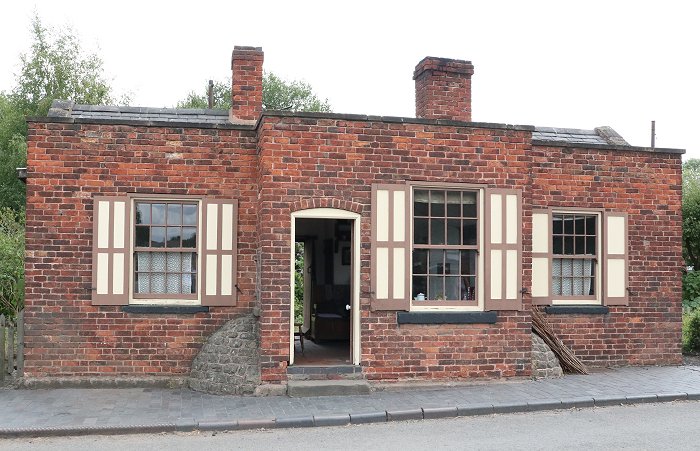
The Woodsetton toll house
at the Black Country Living Museum. |
| There were several turnpike trusts in Tipton
and the surrounding area which looked after some
of the major roads including the A4037 with toll
houses on Dudley Road and Gospel Oak, the A461
at Great Bridge, and the A457 Sedgley to Tipton
road, which opened on 11th November, 1843. One
of the toll houses which came from Woodsetton
has been moved to the Black Country Living
Museum. |
|
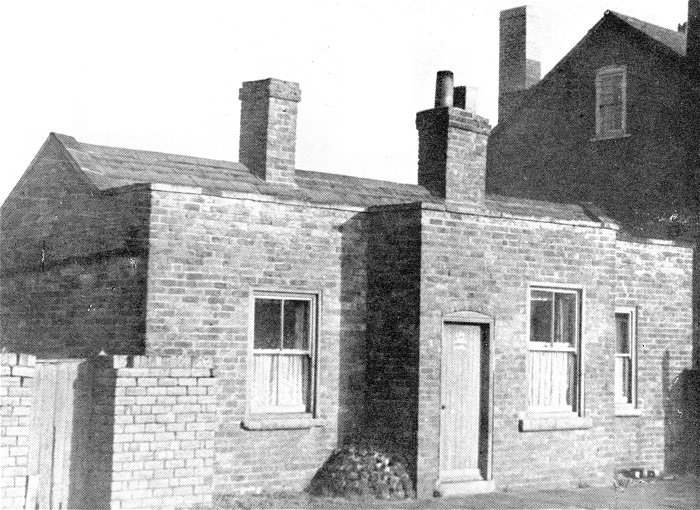
Woodsetton toll house
in its original location. |
|
Tipton’s southern boundary follows the
A4123 Birmingham New Road which was built in the
1920s to relieve the A41 Holyhead Road between
Wolverhampton and Birmingham. Construction was
carried out by Robert McAlpine & Sons at a cost
of £573,750. The road took three years to build
and was designed as a through road, avoiding
town centres. It was officially opened on 2nd
November, 1927 by the Prince of Wales, who with
the Lord Mayor of Birmingham, travelled along
the road to a civic reception in Wolverhampton.
Work began on upgrading the road to a dual
carriageway in 1939. It was completed at a cost
of £39,000. |
|
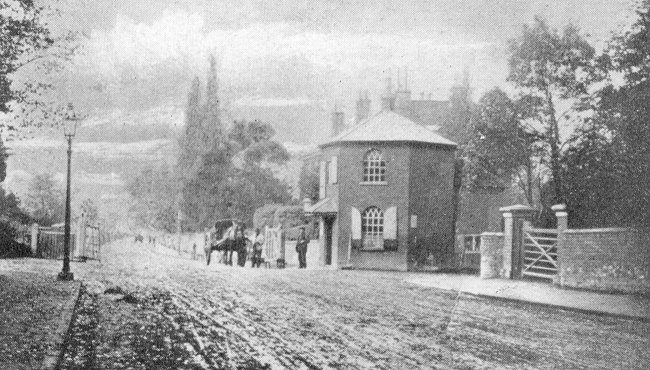
The old toll house and
toll gates on Penn Road, Wolverhampton. From
the Wolverhampton Journal. |
|
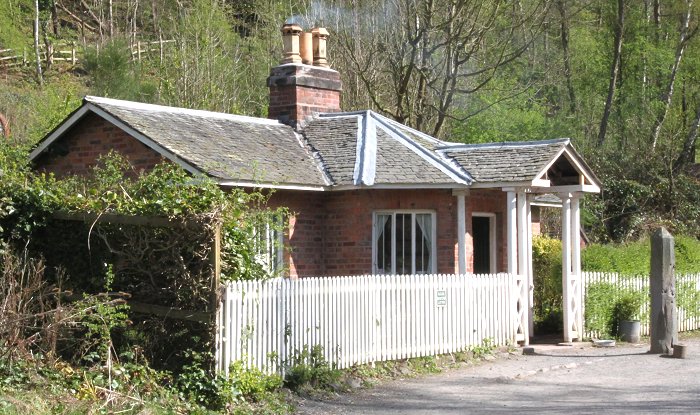
The old Shelton Toll House
at Blists Hill Museum, Madeley. |
|
The Railway Era
The
South Staffordshire Railway
In 1850 Tipton’s first
railway stations opened at Dudley Port and Great
Bridge on the South Staffordshire Railway that
ran between Lichfield and Dudley via Wednesbury
and Walsall. The building of the line was
authorised by an Act of Parliament on 3rd
August, 1846. The line was engineered by John
Robinson McClean, and built in three sections.
The northern section opened on 1st November,
1847, the middle section opened on 9th April,
1849 and the final section from Walsall to
Dudley opened on 8th May, 1850.
John Robinson McClean
leased the railway and agreed to work it himself
for 25 years. There was also the Darlaston
Branch, a branch from Walsall to Cannock Chase,
and a branch to the coal fields near Brownhills,
which all opened later. On 1st February, 1861
the South Staffordshire Railway was leased to
the London & North Western Railway Company, which
purchased the existing 23 locomotives and agreed
to accept delivery of an additional six
locomotives that had been ordered from William Fairbairn & Sons, at Manchester. On 15th July,
1867 the London & North Western purchased the
line, which was absorbed into their network.
|
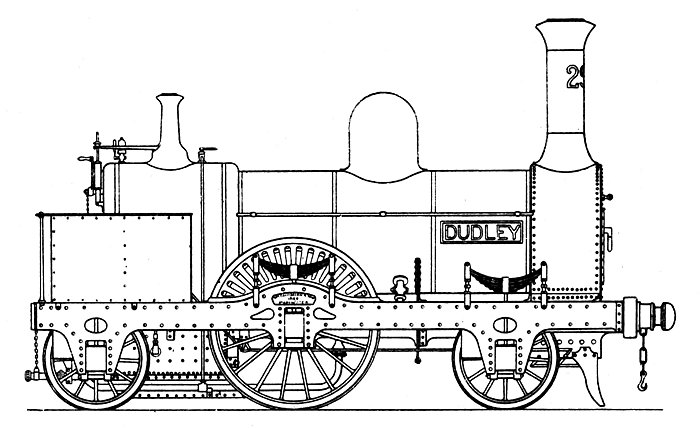
South Staffordshire
Railway's number 1 locomotive 'Dudley',
built by William Fairbairn & Sons. It later
became London & North Western Railway's
locomotive number 297. From The Locomotive
Magazine, January 1898. |
| The last of the batch of six locomotives
ordered from William Fairbairn & Sons was
named 'Tipton'. It is described as a
six-coupled long boiler goods engine. It was
initially numbered as South Staffordshire
Railway number 29, but soon became London &
North Western Railway, number 316. The line officially closed
in 1964 but the Walsall to Round Oak section
continued in use until March 1993.
Tipton Railway Station
Tipton station is on the
Stour Valley Line which was originally known as
the Birmingham, Wolverhampton & Stour Valley
Railway. Construction of the line was authorised
under the terms of an Act of Parliament passed
on 3rd August, 1846. The line had seven
intermediate stations located at Smethwick, Spon
Lane, Oldbury, Dudley Port, Tipton, Coseley, and
Ettingshall Road. After the service had been
established, stations were added at Bushbury,
Albion (near Oldbury), Monument Lane, and
Monmore Green.
It became known as the
Stour Valley Line because of a projected line
from Smethwick to Stourbridge, which never
happened. Wolverhampton High Level Station and
the section to Bushbury belonged jointly to the
London & North Western Railway and the
Shrewsbury & Birmingham Railway, under the terms
of an Act of Parliament passed on 9th July,
1847. This gave both railway companies running
powers over the line, in which they had both
equally invested.
The chief engineers were
Robert Stephenson and William Baker.
Construction quickly began at the Birmingham end
on the 845 yard tunnel into New Street Station.
The line was completed on 21st November, 1851.
It had taken just over four years to build. The
Shrewsbury & Birmingham Railway expected to
start running trains into Birmingham in December
1851, but the London & North Western had other
ideas.
On 10th January 1851 the
Shrewsbury & Birmingham signed a traffic
agreement with the London & North Western’s
rival, the Great Western Railway, which led to an
offer to amalgamate in 1856 or 57. The London &
North Western heard about this and so invoked
their 1847 agreement and denied access to the
Shrewsbury & Birmingham Railway, which led to a
bitter dispute.
Agreement was finally
reached in 1854 and Shrewsbury & Birmingham
trains started to run to Birmingham, but the
London & North Western had set a high fixed rent
for S & B trains using New Street Station. The S
& B finally joined the Great Western Railway on
1st September, 1854 and continued to run their
trains on the Stour Valley line until November
of that year.
|
|
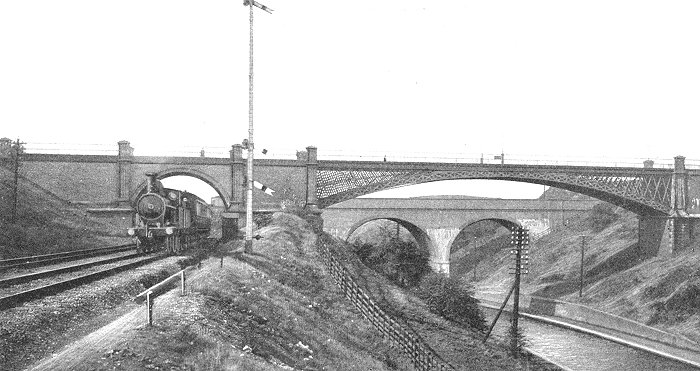
The Stour Valley Line
near Smethwick. From an old postcard. |
|
On 1st February, 1852 the
line was opened for London & North Western
goods, and from 1st March 1853 a half hourly
service started from Wolverhampton to Birmingham
which was designed to prevent the Shrewsbury &
Birmingham from gaining access. The London &
North Western claimed that due to the frequent
service it would now be dangerous for Shrewsbury
& Birmingham trains to run alongside their own.
The line became a
great success. By the 1870s around 120 passenger
trains and 50 goods trains ran daily in and out
of Wolverhampton High Level Station.
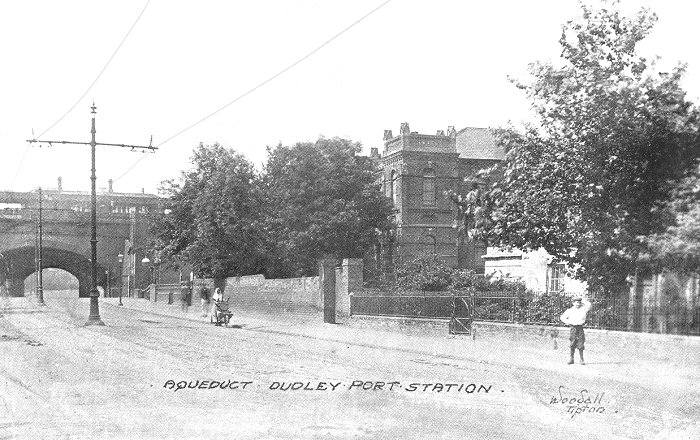
From an old postcard.
The Oxford, Worcester &
Wolverhampton Railway
The railway was built under
the terms of an Act of Parliament dated 4th
August, 1845 which authorised the railway
company to construct a line from the Oxford &
Rugby Railway at Wolvercot Junction to
Worcester, Stourbridge, Dudley, and
Wolverhampton, with a branch to the Grand
Junction Railway at Bushbury. It was to be a
mixed gauge line, partially funded by the Great
Western Railway. The chief engineer was I. K.
Brunel who greatly underestimated the
construction cost.
By 1st June, 1849 all of
the available money had been spent. Only the
middle section had been partially completed, so
the Railway Commissioners ordered the Great
Western Railway to complete the line. The GWR
refused, and a legal battle commenced. As a
result of the financial problems it became known
as 'the old worse and worse.' The line
was eventually completed by April 1854, and
opened in its entirety on 1st July, 1854.
The section from Evesham to
Stourbridge had opened on 3rd May 1852, but as
little money was available, six second-hand
locomotives had to be acquired. The Stourbridge
to Dudley section opened to goods traffic on
16th November, 1852, and to passenger traffic on
20th December, 1852. By this time the company
had ordered twenty locomotives from R and W
Hawthorn Limited, at Newcastle upon Tyne.
On 4th June, 1853 the
section from Wolvercot Junction and Evesham
opened, and on 1st December, 1853 the line
opened between Dudley and Tipton. Tipton was
later called Tipton Five Ways to avoid confusion
with the station in Owen Street. There were four
intermediate stations between Tipton and
Wolverhampton: Princes End, Daisey Bank (later
called Daisy Bank), Bilston, and Priestfield.
|
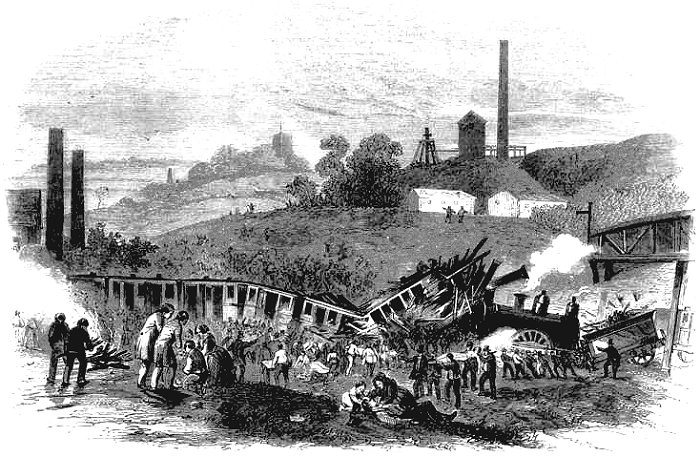
On 23rd August, 1858 a children's excursion from Wolverhampton
to Worcester carrying 1,500 passengers in thirty seven
coaches had a number of mechanical problems. On the way to Worcester some of the couplings were
broken, and so the train returned in two halves, the first
consisting of thirty coaches. Unfortunately the still
overloaded train broke in half at Round Oak
and ran down a bank near Brettell Lane. As it travelled down
the bank out of control it ran into the
second train killing fourteen people and injuring fifty others.
Image from the Illustrated Times, 4th September, 1858. |
|
By August 1862 eleven
trains ran daily from Wolverhampton to Oxford,
the fastest time being 3hrs 25mins. There were
also trains to Evesham, Worcester and Dudley.
Tipton Five Ways Station
eventually closed in 1962, though the line
remained open until 22nd September,
1968. The station buildings were soon
demolished. |
|
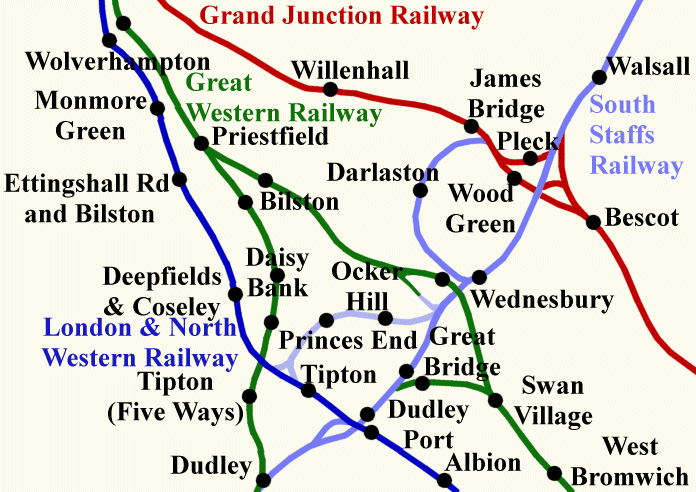
The complex local rail
network. |
|
 |
 |
 |
|
Return to
Canals |
Return to
the
beginning |
Proceed to
Local Government |
|